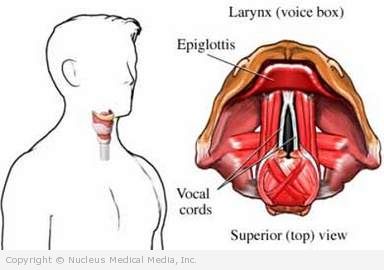Laryngeal Cancer
(Cancer of the Larynx; Cancer of the Voicebox )
Laryngeal cancer – Definition
Laryngeal cancer is a disease in which cancer cells grow in the larynx. The larynx is a tube-shaped organ inside the neck that lies between the throat and the windpipe. Its main function is to produce sound for speaking.
Cancer occurs when cells in the body (in this case laryngeal cells) divide without control or order. Normally, cells divide in a regulated manner. If cells keep dividing uncontrollably when new cells are not needed, a mass of tissue forms, called a growth or tumor. The term cancer refers to malignant tumors, which can invade nearby tissues and can spread to other parts of the body. A benign tumor does not invade or spread.
Laryngeal cancer – Causes
The cause of laryngeal cancer is unknown.
Laryngeal cancer – Risk Factors
A risk factor is something that increases your chance of getting a disease or condition.
Risk factors include:
- Smoking (the most common high-risk behavior)
- Excessive use of alcohol
- Race: Black
- Age: 55 or older
- Sex: male
- Occupational exposure to certain air pollutants such as wood dust, chemicals, and asbestos
- Gastroesophageal reflux (GERD) — stomach acid that backs up into the esophagus and throat where it may come in contact with the larynx
- Weakened immune system
- Laryngeal dysplasia (a precancerous condition)
Laryngeal cancer – Symptoms
Symptoms may include:
- Persistent cough, hoarseness, or sore throat
- Abnormal lump in the throat or neck
- Difficulty swallowing
- Pain when swallowing
- Frequent choking on food
- Difficulty breathing
- Noisy breathing
- Persistent ear pain or an unusual ear fullness or sensation in and around the skin of the ear
- Unplanned, significant weight loss
- Persistent bad breath
These symptoms may also be caused by other, less serious health conditions. If you are experiencing these symptoms, see your healthcare provider.
Laryngeal cancer – Diagnosis
Your doctor will ask about your symptoms and medical history, and perform a physical exam. Tests may include:
- Laryngoscopy — a thin, lighted tube inserted down the throat to examine the larynx
- Biopsy — removal of a sample of laryngeal tissue to test for cancer cells
- Chest x-ray — a test that uses radiation to take a picture of the larynx and nearby structures
- Computed tomography (CT) scan — a type of x-ray that uses a computer to make pictures of the inside of the larynx
- Magnetic resonance imaging (MRI) scan — a test that uses magnetic waves to make pictures of the inside of the larynx
Laryngeal cancer – Treatment
Once laryngeal cancer is found, staging tests are performed to find out if the cancer has spread and, if so, to what extent. Treatment depends on the stage of the cancer. For early stage laryngeal cancer, either surgery or radiation alone is the most common and appropriate therapies offered. For more advanced disease, either radiation (with chemotherapy) or surgery followed by radiation is the most common treatment given.
Treatment includes:
Surgery
Surgery requires removal of a cancerous tumor and nearby tissue, and possibly nearby lymph nodes. Surgeries for laryngeal cancer include:
- Total laryngectomy — This involves the removal of the larynx, including the vocal cords.
- Partial laryngectomy—In this procedure, the surgeon removes the cancerous tissue while leaving as much of the vocal cords as possible.
- Tracheotomy — To help with breathing, a hole is made in the neck below the larynx. This may be temporarily necessary after surgery, or permanently placed in the case of laryngeal tumors that are too large to be removed.
- Neck dissection — This involves the removal of the lymph nodes and part of the neck muscles to determine the spread of cancer.
Radiation Therapy (or Radiotherapy)
Radiation therapy is the use of radiation to kill cancer cells and shrink tumors. This may be external radiation therapy, where the beam is directed at the tumor from a source outside the body.
Chemotherapy
Chemotherapy is the use of drugs to kill cancer cells. This form of treatment may be given in many forms including pill, injection, and catheter. The drugs enter the bloodstream and travel through the body killing mostly cancer cells, but also some healthy cells. Chemotherapy may be used to reduce the size of a particularly large cancer.
Laryngeal cancer – Prevention
Since laryngeal cancer is extremely rare in nonsmokers, the best way to prevent this type of cancer is by not smoking. Other measures you can take to reduce your risk of laryngeal cancer include:
- Avoiding excessive alcohol use
- Protecting yourself from toxic exposures that have been linked to laryngeal cancer

